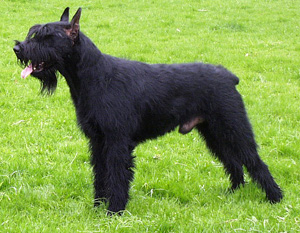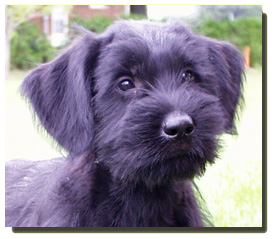
Giant Schnauzer
Group: Working Group
Origin: Germany
Height:
- – Male: 25.5 to 27.5 inches (65-70cm)
– Female: 23.5 – 25.5 inches (60-65cm)
Other Names: Münchener Dog; Riesenschnauser

Ch Riesenra’d Tyche von Ulrich CGC BH
Photo: Berendhaus Kennel
CLICK HERE to View Breeder Listings
Breed Profile
The Giant Schnauzer is believed to have originated near Munich, Germany. Originally used as a cattle driver, and later as a guardian and police dog, the breed also served with valour during two world wars.
The Giant Schnauzer closely resembles the smaller Standard and Miniature Schnauzers. However, these are three separate and distinct breeds. He is larger and more powerful than the Standard and gives an impression of strength, courage, and nobility.
The Giant Schnauzer is intelligent, easily trained, reliable, versatile, bold, and good-natured. He is an excellent guard dog, deeply loyal to his family, and especially good with young children and other pets within his family — He may, however, show aggression toward strange children or animals.
Today, the Giant Schnauzer is not only a good family companion and protector but he is also seen working as a Police Dog, Sniffer Dog, in Search and Rescue and as a Therapy Dog. The Giant also enjoys various dog sports and activities, such as obedience, agility, and herding.
His coat is strong, hard and wiry, short on the ears, head and throat, and slightly longer on the legs and under the chest. He has a beard and eyebrows that add to the rectangular look of his head. He also has a soft and dense undercoat. In colour, he is either a deep, solid black or salt-and-pepper.
Health Issues
Like all breeds of dogs, the Giant Schnauzer is susceptible to certain health problems, including:
- Canine Hip Dysplasia
- Bloat/Gastric Torsion
If you are considering the adoption of a Giant Schnauzer puppy, or any breed, it is very important to be selective in choosing a responsible and reputable breeder. Ensure that the prospective puppy’s parents have all health clearances. For the Giant Schnauzer this should include being x-rayed clear of Hip Dysplasia. Breeding of any dog should not be done until after they have been proven to be free of evidence of significant hereditary diseases. (For more information on selecting a breeder, see the articles on the General Information page.)
Additional Health Resources:
- First Aid for Bloat Prepared by: Siefried Zahn D.V.M — This article uses a Great Dane as an example, however, it can be applied to other breeds. This condition is an emergency, requiring immediate veterinary action. The condition is most often found in large, deep chested dog breeds and anyone owning a deep chested breed should be prepared to handle the emergency procedures necessary, including having readily available the name and phone number of emergency clinics and/or after-hours Veterinarians.
- Canine Health Information Center (CHIC) — Providing a source of health information for owners, breeders, and scientists that will assist in breeding healthy dogs. CHIC is a centralized canine health database jointly sponsored by the AKC/Canine Health Foundation (AKC/CHF) and the Orthopedic Foundation for Animals (OFA).
- Health and Nutrition — Growing section of the Canada’s Guide to Dogs website which includes information on several health and nutrition related issues.
- AKC Canine Health Foundation — Working towards developing scientific advances in canine health.
- OFA – Companion Animal Eye Registry (CAER)
- Orthopedic Foundation for Animals (OFA)
- Ontario Veterinary College (OVC)
- University of Pennsylvania Hip Improvement Program (PennHip)
- HealthGene — HealthGene Corporation is the leading provider of veterinary DNA diagnostic services in Canada.
- Labgenvet — Laboratory of Veterinary Genetics is a Canadian diagnostic laboratory that offers a comprehensive service of DNA tests for veterinary genetic diseases.

Gossip vom Klingsgarten
Photo: Berendhaus Kennel
Grooming Information
The Giant Schnauzer’s wiry coat requires regular maintenance. This is a breed that does not shed; therefore, the coat must be stripped or clipped regulary (about every 8 to 10 weeks) and brushed or combed weekly to help prevent matting.
- Grooming Tips From the Giant Schnauzer Club (UK)
- Grooming — This section of the Canada’s Guide to Dogs website includes tips, articles and information covering all aspects of dog grooming along with a listing of Groomers from across Canada.
Training Resources
Early socialization and obedience training are strongly recommended for the Giant Schnauzer.
- Training — For training information, see this growing section of the Canada’s Guide to Dogs website for tips, articles, as well as listings of training centres across Canada.
Additional Information
- Herding Dogs — A section of the Canada’s Guide to Dogs website which includes training and general information about Herding/Stock Dogs; listing of Stock Dog Clubs and Associations; listing of upcoming shows and events; and more.
- Clubs, Sports & Activities — For information on the many sports and activities you can get involved in with your dog.
- Working Dogs — The Working Dogs section of the Canada’s Guide to Dogs website provides information and listings of organizations that are involved in various dog jobs, such as Guide Dogs, Therapy Dogs, Police Dogs, Protection Dogs, and much more.
*NOTE 1: CHIC – The Canine Health Information Center “is a database of consolidated health screening results from multiple sources. Co-sponsored by the Orthopedic Foundation for Animals (OFA) and the American Kennel Club (AKC) Canine Health Foundation, CHIC works with parent clubs to identify health screening protocols appropriate for individual breeds. Dogs tested in accordance with the parent club established requirements, that have their results registered and made available in the public domain are issued CHIC numbers.” To learn more, visit: www.caninehealthinfo.org
*NOTE 2: The Fédération Cynologique International (FCI) is the World Canine Organization, which includes 91 members and contract partners (one member per country) that each issue their own pedigrees and train their own judges. The FCI recognizes 344 breeds, with each being the “property” of a specific country. The “owner” countries write the standards of these breeds in co-operation with the Standards and Scientific Commissions of the FCI, and the translation and updating are carried out by the FCI. The FCI is not a breed registry nor does it issue pedigrees.
Breed Listing

The Ultimate Giant Schnauzer Dog Manual
Giant Schnauzer book for care, costs, feeding, grooming, health and training
Quick Links
Get In Touch
- Email: canadasguidetodogs@gmail.com
- Email: info@canadasguidetodogs.com
- Visit us on Facebook: www.facebook.com/CanadasGuideToDogs
— CanadasGuideToDogs.com is an Amazon Associate as well as a participant in various affiliate programs, as such fees are earned from qualifying purchases.
